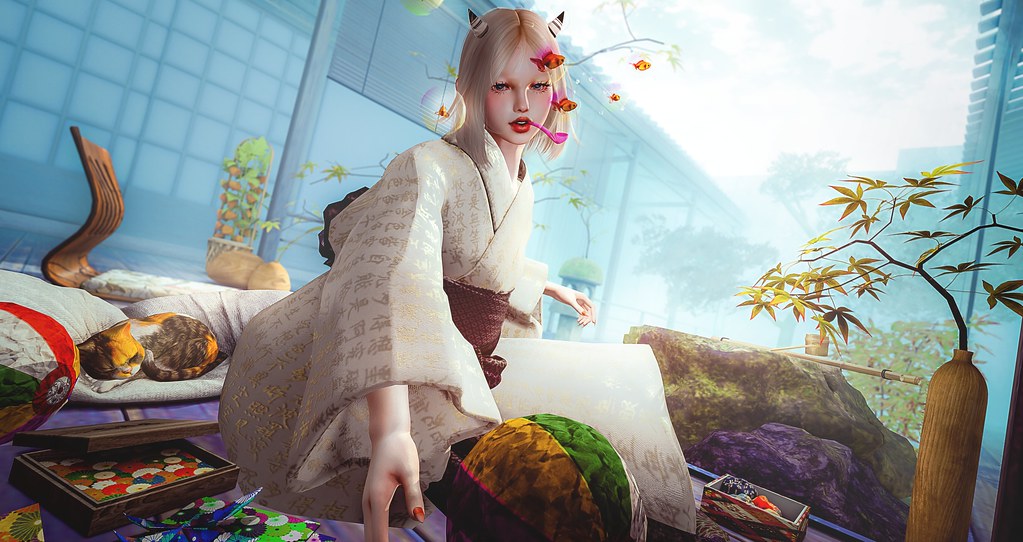#tsukubai
Text

305 notes
·
View notes
Photo

Several pictures of my visit to Iwato-ochiba-jinja, located in rural Northern Kyoto along the Kiyotaki River.
#Ginkgo tree#Iwato-ochiba-jinja#Kita-ku#Kyōto#Tsukubai#autumn#autumn photography#イチョウの木#岩戸落葉神社#蹲踞#銀杏の木
67 notes
·
View notes
Photo


Watercolour art - a waterfall and a tsukubai
#watercolor#art#watercolour art#waterfall#tsukubai#moss#green#illustration#forest#watercolour illustration#aesthetic#nature
32 notes
·
View notes
Photo

Ideas for gravel landscaping in a medium-sized, Asian backyard.
0 notes
Photo

Ideas for gravel landscaping in a medium-sized, Asian backyard.
#Ideas for gravel landscaping in a medium-sized#Asian backyard. art glass#axis mundi#tsukubai#japanese stools#ipe wood
0 notes
Text

A tsukubai is to be found in a tea garden and is formally composed of a wash basin, chouzubachi and Yaku-ishi, a number of special purpose stones. It has a background and often a garden lantern, tourou or more often as ishi doro. The term tsukubai refers to the whole of this composition as such. The tsukubai or crouching bowl, literally "stooping basin" was designed to humble guest and create the right state of mind before guests joined the tea ceremony. Many Japanese gardens today have both the chozubachi and tsukubai and are often fed with water from a bamboo spout called "kakei".
In Japan, a tsukubai is a washbasin provided at the entrance to holy places for visitors to purify themselves by the ritual washing of hands and rinsing of the mouth. This type of ritual cleansing is the custom for guests attending a tea ceremony or visiting the grounds of a Buddhist temple. The name originates from the verb tsukubau meaning "to bow down", an act of humility.
Tsukubai are usually of stone, and are often provided with a small scoop, laid across the top, ready for use. A supply of water is provided via a bamboo pipe called a kakei.
<><><><><><><><><><><><><>
Sanzenin Temple is the main attraction of the rural town of Ohara, which is located about an hour north of central Kyoto. The approach from Ohara bus stop to Sanzenin is lined with shops and restaurants catering to temple visitors, and there are a number of smaller temples in the vicinity. Sanzenin Temple itself has large temple grounds and a variety of buildings, gardens and walking paths.
Sanzenin is a temple of the Tendai sect of Japanese Buddhism and was founded by nobody less than the revered monk Saicho who introduced Tendai Buddhism to Japan in 804. Sanzenin is a monzeki temple, one of only a few temples whose head priests used to be members of the imperial family.
A tranquil atmosphere permeates the garden, and there are a number of amusing stone statues that peek out from the moss.
40 notes
·
View notes
Photo


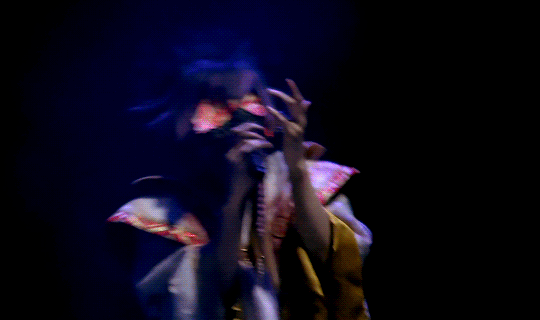

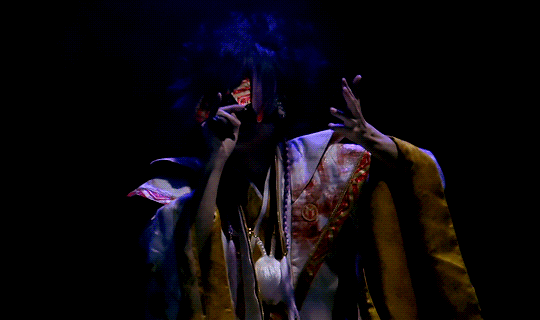

Tsukubai | Kiryu Seitan Juugo Shuunen Kinen Kouen
2 notes
·
View notes
Quote
The crescent moon
shines from underwater—
spring rain
Hijikata Toshizo
Original: 三日月の水の底照る春の雨
Read all of Hijikata’s haiku poems here: https://shinsengumi-archives.tumblr.com/post/683071924948058112/hijikata-toshizos-haiku-poems
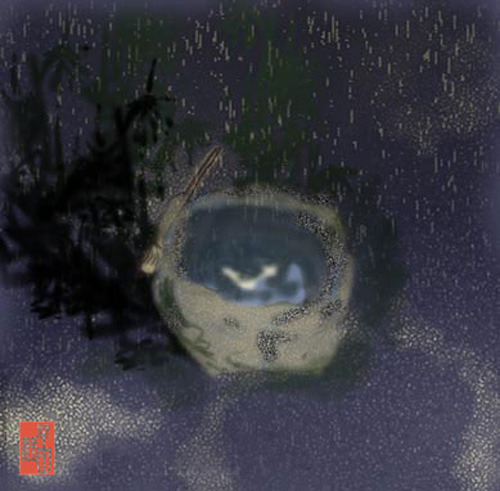
image source: WhiteWind歴史館
fushigi-dono:
Hijikata says "the young moon shines at the bottom of the water," so a body of water could be something quite shallow: a puddle, a small pond in the garden, or a stone bowl for washing hands. For example, such bowls, called tsukubai, were placed near temples and tea houses:


When it rains, the sky is usually covered with clouds and the moon is out of sight. Either it is a tiny drizzle or the thin moon peeked out of the clouds and was reflected in the water among the raindrops. But you still have to notice it! Toshizo noticed and was impressed :)
Still, in the depths of his soul, "at the very bottom of the water", he was a great romantic
WhiteWind歴史館:
The crescent moon
shines from the bottom of the water
Spring rain
A straightforward interpretation would be, "In the rain, a crescent moon can be seen at the bottom of the water.
The fact that the moon is shining in spite of the rain, and that it is a crescent moon that can only be seen low in the western sky, gives this haiku a very strange feeling.
It makes us wonder about the position of the crescent moon reflected in the water, and how it was positioned for Toshizo to see it.
What kind of "water" was it that Toshizo was looking at? Since we can see the "bottom" of the water, it must have been a small pool of water like the "tsukubai" in the garden of a tea ceremony room.
The moonlight peeking through the clouds in the spring rain may have shimmered in the water for a short while. The shape of the moon on the surface of the water, slightly rippled by the drops of rain, may have looked like a crescent moon...
In any case, it seems certain that Toshizo, who was fascinated by the ethereal scene of rain, water, and the moon, was a considerable romantic*.
*romantic
In the dialogue from "Shinsengumi!! Hijikata Toshizo's Last Day", which was broadcast as a sequel to the NHK Taiga drama "Shinsengumi!” by Koki Mitani, the word "romanticist" used by Enomoto Takeaki was quoted by Toshizo forcibly abbreviated.
#poem#quote#hijikata quote#Hijikata#translated#translated from Japanese#fushigidono#series: hijikata haiku#hijikata poem
3 notes
·
View notes
Text
Nampō Roku, Book 7 (78): Concerning the Chōzu-bachi.

78) The place where the chōzu-bachi should be installed has not been fixed¹. In general, with respect to the chōzu-bachi, large rare and attractive stones are unnecessary². As for the basin [that is carved into the stone], the water of a small hand-bucket should be enough to cause it to overflow freely³.
In [the roji of] Jōō’s Yamazato[-no-iori], during the [spell of] intensely hot weather [that followed the end of the rainy season], [Jōō] took a branch of brushwood and, after refreshing [the water in the chōzu-bachi], rested [the branch across the mizu-tame] -- to protect the water from [the heat of] the sun⁴.
_________________________
◎ This text appears to have been written by someone who was following the machi-shū tradition that was derived from the teachings of Imai Sōkyū since, in addition to obliquely criticizing Rikyū’s apparent use* of larger, rather dramatic stones for his tsukubai, it also describes Jōō’s way of protecting the water in the chōzu-bachi from the heat of the sun in an authoritative way (yet without any sort of input from Rikyū)†.
In Shibayama Fugen’s toku-shu shahon, this rather short text is included as a second kaki-ire under entry 77. However, in both the Enkaku-ji manuscript, and the genpon version of the Nampō Roku, it is presented as a separate entry, and this is the formatting that I have followed in this translation.
As has been the case in all of the recent entries, the toku-shu shahon and genpon versions include a number of modifications that would have been difficult to include together with the Enkaku-ji text, so it seemed best to consider that version of the text separately -- as an appendix (that will be included at the end of this post).
___________
*The only two surviving tsukubai that are supposed to have been made to Rikyū’s design are those in the roji of Omotesenke and Urasenke (see footnote 2). Both of these, which are said to have come from the roji of Rikyū’s last two sukiya (the Juraku-yashiki [聚樂屋敷], and that at Mozuno [百舌鳥野], respectively) feature a small basin (of the sort described in this entry) hollowed out in a much larger, rather dramatic, stone -- exactly the kind of chōzu-bachi that the text of this entry states Rikyū abhored.
†Since the brushwood would necessarily come into direct contact with the water -- which the host had just refreshed (to insure its purity) -- despite the fact that (at least according to Rikyū’s teaching) the guests would be coming forward to make use of it immediately, placing a brushwood branch over the mizu-tame would seem to risk contaminating the water unnecessarily. This seems to suggest that the source of this story (and so the teaching itself) was someone other than Rikyū.
Imai Sōkyū comes to mind as the most likely source for this intelligence because, besides Rikyū, he was commonly believed to have had the closest association with Jōō, and so was the most likely source for such stories. (Imai Sōkyū’s teachings were mostly based on what he claimed to have been Jōō’s tea practices from his middle period -- the decade or so that passed while Rikyū was on the continent -- suggesting that there was a certain confusion, in the mind of the author of this text, regarding precisely when the Yamazato-no-iori [山里ノ庵] was actually built.)
¹Chōzu-bachi sue-dokoro fujō nari [手水鉢スヘ所不定也].
Chōzu-bachi sue-dokoro [手水鉢据え所] means the spot where the chōzu-bachi is to be placed.
Fujō nari [不定なり] means it is not fixed; it has not been determined (with certainty.
In other words, there is a certain amount of flexibility with respect to where the tsukubai may be placed in the roji.
²Sōjite chōzu-bachi, mezurashiku migoto-naru ō-ishi nado mu-yō nari [惣而手水バチ、メツラシク見事ナル大石ナド無用也].
Sōjite [総じて] means generally, in general, ordinarily, on the whole.
Mezirashiku migoto-naru ō-ishi nado [珍しく見事なる大石など]: mezurashiku [珍しく] means rare, uncommon, unique; migoto-naru [見事なる] means something that is beautiful, gorgeous, superb, and so forth; ō-ishi nado [大石など] means large stones (or boulders), and the like.
This is referring to tsukubai that were hollowed out in rocks that are beautifully colored or curiously shaped, as well as those cut in rocks that are significantly larger than the basin that will be cut into them*.
Mu-yō nari [無用なり] means (is) unnecessary; (is) not called for.

Two examples of what is meant here would be the two tsukubai -- in the roji of Omotesenke and Urasenke, respectively -- shown above. According to this entry, Rikyū is quoted as saying -- or being made to say -- that such tsukubai are unnecessary†.
__________
*In the second entry in Book One, Rikyū is quoted as having said:
sore-yue ni koso, Jōō i-rai, chōzu-bachi no mizu-tame ha, ko-teoke hitotsu no mizu ni te, zorori to koboruru-hodo no ōkisa ni kiritaru ga yoki to mōsu nari to kotaerare-shi
[夫故にこそ、紹鷗已來、手水鉢の水ためは、小手桶一つの水にて、ぞろりとこぼるゝほどの大さに切たるがよきと申也と被答し]
This means “that is the reason why, since the time of Jōō, it has been said that the basin for the water in the chōzu-bachi should be cut to a size that can be easily filled to overflowing with the water of a small hand-bucket.”
The size of the basin, then, was determined by the size of the common hand-bucket since, by definition, the basin should overflow freely when this amount of water is poured in.
†And, by implication, such chōzu-bachi should not be used for chanoyu. Which, since the two tsukubai shown above are said to have come from the Rikyū’s last two roji (Omotesenke’s chōzu-bachi was from Rikyū’s Juraku-yashiki, while that installed in Urasenke’s roji was supposed to have been the one rescued from the Mozuno compound prior to its obliteration following Rikyū’s seppuku) means that either this entry, or the attribution of these two large tsukubai to Rikyū, has to be questioned.
³Mizu-tame ha, ko-teoke no mizu no, zorori to nagaruru-hodo to iu-iu [水タメハ、小手桶ノ水ノ、ゾロリトナガルヽホドト云〻].
Mizu-tame [水溜め] refers to the basin-shaped depression* that is cut into the stone. The first chōzu-bachi preferred for use in chanoyu were antique foundation stones, so the hole had originally been cut to receive the lower end of the structural pillar that the stone would support. It appears that it was not until sometime after Jōō’s death that people began to order chōzu-bachi to be crafted de novo (rather than reusing stones that had been salvaged from an ancient building project, as Jōō and his closest followers had done) -- meaning that, since the idea of their being a foundation stone was no longer an issue, more interesting stones, of varying sizes and shapes (and even novel or mottled colors), came to be used. It was at this time that the question of the precise dimensions of the basin were raised, and the matter was disposed of as narrated here.
A ko-teoke [小手桶] is a specific kind of hand-bucket. This bucket (shown below), holds approximately 4 liters (when filled to approximately 70% of capacity -- the volume that will allow the hand-bucket to be carried freely without danger of its dripping or splashing)†.

The size is, therefore, about the size of a large mizusashi (the diameter at the mouth is 8-sun, and the width across the handle, 8-sun 5-bu: occasionally, ko-teoke were used by certain wabi chajin as mizusashi, since they were not so much larger than the shin-teoke -- albeit because they were unpainted, as seen above, they were very rustic in appearance‡).
Ko-teoke no mizu [小手桶の水] means the (amount of) water (that could be contained) in a small hand-bucket.
Zorori to nagareru-hodo [ぞろりと流れるほど]: zorori [ぞろり] means a great number, or large quantity, of something; nagareru-hodo [流れるほど] means to flow out in excess of (what is needed to fill the basin).
In other words, the water should be more than what is necessary to overflow the basin (thereby flushing out what water remains**, before filling it again with fresh water).
__________
*The word mizu-tame [水溜め] literally means a reservoir or cistern.
†The basin (mizu-tame) carved into the tsukubai for a small room generally holds just over 2 L of water. This means that, when replenished from a small hand-bucket, the mizu-tame will overflow fully and freely.
The mizu-tame carved in tsukubai intended for the roji of a 4.5-mat room were usually somewhat larger (generally holding around 2.5 liters of water); while those for the large reception-room style of shoin were even larger still (and often equipped with a water-spout of some sort that would allow them to be continually refilled without the necessity of an underling having to carry buckets of water constantly to replenish what had been used).
‡Because the maximum width (measured across the handle) is 8-sun 5-bu, while on the o-chanoyu-dana the seat of the mizusashi is 9-sun square, certain traditions hold that Shukō used a ko-teoke as the mizusashi on the o-chanoyu-dana that was built into the wall of his 2-mat Shukō-an [珠光庵].
In part, his idea may have been that, since the ko-teoke was filled at the well, using it as the mizusashi would protect the water from subsequent contamination (when transferred into another mizusashi). This way of thinking would, then, have laid the foundations for the paradigm under which the kiji-tsurube came to be used the same way by Rikyū almost a century later.
**The host uses the ladle to empty the basin before refilling it. However, he must be careful not to damage the cup of the ladle while performing this procedure (since the bottom and sides of the basin are usually rough), meaning that a certain amount of water will yet remain in the bottom of the basin. Filling the basin to the point of overflowing was felt to be a way to flush this remaining water out as the basin was being refilled.
It should be added that, in anticipation of the gathering, the host carefully cleans and disinfects the basin with rock-salt first, and then flushes it several times prior to the arrival of the guests. Then, just before they are expected, the host empties and fills the basin again with fresh water. It is this water that the host then changes after the guests have taken their seats in the koshi-kake (this is why, in his comments reproduced in the preceding post, that Tanaka Senshō argued that the host should use that water to wash his own hands and mouth before replenishing the water in the basin, and so turning to invite the guests into the sukiya for the shoza: that water would have been in the basin for only a matter of 10 or 15 minutes at most, and so would have been completely fresh when the host brought out the hand-bucket to refresh it).
⁴Jōō no Yamazato ni te goku-sho no toki, ao-shiba ichi-eda, chōzu-mizu aratamete ato ōite, hi wo sakerare-shi to iu-iu [紹鷗ノ山里ニテ極暑ノ時、靑柴一枝、手水水アラタメテ後ヲヽイテ、日ヲサケラレシト云〻].
Jōō no Yamazato [紹鷗の山里] is referring to Jōō’s Yamazato-no-iori [山里ノ庵], the original (2-mat daime) small room that Jōō built during the spring or early summer of 1555. Jōō no Yamazato ni te [紹鷗の山里にて], therefore, means that the following narrative is concerned with the chōzu-bachi in the roji of Jōō’s Yamazato-no-iori.
Goku-sho no toki [極暑の時] means during the spell of intensely hot weather (that follows the end of the rainy season).
Ao-shiba ichi-eda [靑柴一枝] means (Jōō took) one branch of brushwood....
Chōzu-mizu aratamete ato ōite, hi wo sakerare-shi [手水水改めて後覆いて、日避けられし]: chōzu-mizu aratamete ato [手水水改めて後] means after the hand-washing water had been refreshed (by pouring the bucket of fresh water into the mizu-tame); ōite [覆いて] means to lay something on top as a cover; hi wo sakerare-shi [日避けられし] means to ward off or shelter (the water in the basin) from (the hot rays of) the sun.
So what this is saying is that, during the spell of unbearably hot weather that followed the end of the rainy season, Jōō, after replenishing the water in the chōzu-bachi, covered the basin with a leafy branch of brushwood, to protect the water from the heat of the sun -- thereby keeping the water fresh and cool for the guests when they arrived to rinse their hands and mouths.
Since the Yamazato-no-iori was built during the spring or early summer of 1555 (as the rainy season was developing), this idea occurred to Jōō after the end of that first rainy season. It was just his spontaneous response to the heat -- probably the result of his being closely associated with this small tea room over the course of the whole day, every day (as the rules for the sō-an dictated*). Jōō, of course, died toward the end of that year, so his ideas never had the chance to develop any further.
__________
*The host was supposed to enter the sō-an before dawn, so he could sweep and clean the mats, and prepare the ro. Then, after spreading a layer of embers on the floor of the ro, and dusting over these lightly with shimeshi-bai, the host would lay a full set of charcoal in the ro, and then go out and draw water from the well for the day’s chanoyu as dawn broke. Having rinsed and filled the kama, it would be brought out and lowered into the ro, over the fire that would now be kindling strongly.
Then, in the absence of a morning gathering, the host would attend to his morning prayers, take his morning meal, and take care of any matters in the sō-an, and its roji, that required his immediate intervention.
Around noon (assuming there had not been a morning gathering), the host would lift the kama out of the ro, clean the interior of the ro and rebuild the fire, refill the kama (from a kata-kuchi), and then return it to the ro.
Since it was not usual for gatherings to be held between the noon hour and dusk (for yin-yang reasons), the host would spend the afternoon cutting charcoal, preparing shimeshi-bai (in the sō-an, the ro was supposed to be used all year round, so a daily supply of shimeshi-bai was needed), and taking care of the roji and the small vegetable-garden (where hakusai [白菜], daikon [大根], and other vegetables were cultivated, in addition to some flowers for chabana -- growing the flowers in the garden was the only way that the host could guarantee that they were truly “of the moment” for that place).
At dusk the host would return to the tea room and lift the kama out of the ro, and take it back to the mizuya (where it would be emptied, washed, and refilled with cold water from the storage jar); then the ro would be emptied, cleaned, and a small shita-bi [下火] returned around which a full set of charcoal would be laid. Then the wet kama would be returned to the ro.
If there was no gathering scheduled for the evening, the host would attend to his religious observations as the sun set, and then take his evening meal. After dark he would again check on the fire, adding additional charcoal and refilling the kama as needed. Then, toward the end of the second hour of darkness, he would take the fire out of the ro, and close the room up for the night.
This, according to the teaching of san-tan san-ro [三炭三露] (which was articulated during those last months of Jōō’s life) is how the host was supposed to conduct himself every day throughout the year.
==============================================
❖ Appendix: the Toku-shu Shahon Version of Entry 78.
78) In general, using an attractive and wonderfully interesting large stone for the chōzu-bachi -- this was something that Rikyū detested⁵. Yet it just seems somehow old fashioned for the basin to be carved [to such a small size] that the water of one small hand-bucket could make it overflow⁶.
At Mozuno, [the chōzu-bachi] was intentionally placed nearby the well⁷. But in other cases, according to [the design of] the roji, the location where [the chōzu-bachi] should be installed has not been specified⁸.
In the case of the chōzu-bachi at Jōō’s Yamazato[-no-iori], during a time of intensely hot weather [Jōō] cut a branch of green brushwood, and after refreshing the hand-washing water, he laid [the branch] over [the water] as if it were a lid -- to protect [the water] from [the heat of] the sun⁹. This [story] is [referring to] a place that everyone knows -- such was [Ri]kyū’s story.
_________________________
◎ This version of the entry is more story-like -- though it also deviates from the original, occasionally moving farther from the truth (in the direction of Edo period tea preferences) than its author may have intended.
⁵Sōjite chōzu-bachi ni migoto-naru mezurashiki ō-ishi nado sue-shi-koto, Kyū ha kirawaru [総テ手水鉢ニ見事ナル珍敷大石抔据シコト、休ハ嫌ハル].
Sōjite chōzu-bachi ni migoto-naru mezurashiki ō-ishi nado sue-shi-koto [総じて手水鉢に見事なる珍しい大石など据えしこと] means in general, placing out a chōzu-bachi (carved in) a beautiful, wondrous large stone....
Kyū ha kirawaru [休は嫌わる] means ...(this kind of chōzu-bachi) was hated by Rikyū.
Here Tanaka’s genpon text somewhat broadens the description of the kind of chōzu-bachi that was disliked by Rikyū: sōjite chōzu-bachi iro-iro ni migoto-naru ishi wo suwe-shi-koto, Rikyū ha kirawaru [総テ、手水鉢イロ〰ニ見事ナル石ヲスヱシ事、利休ハキラハル]. This means “in general, placing out chōzu-bachi (made from) various sorts of beautiful stones -- Rikyū hated (when people did things like this).”
Since the two large chōzu-bachi-ishi shown above (under footnote 2) were, in fact, described (by Rikyū’s contemporaries) as being made from strikingly beautiful and interesting large stones, either Rikyū did not actually utter this pronouncement*, or the two tsukubai in question never belonged to Rikyū.
__________
*As mentioned in the introduction, this argument, coupled with the story of Jōō resting a branch directly on the rim of the basin that had been cut in his own tsukubai (which is something that Rikyū would not have approved, since it could potentially render the water unclean), seems to have come from followers of Imai Sōkyū’s machi-shū followers. Whether the Sen family bought into this notion during the seventeenth century or not, however, is unclear.
It appears that, by the time this text was written, the roji of the Omotesenke, at least, had already been constructed with “Rikyū’s chōzu-bachi” as its centerpiece. The Yūin [又隠], meanwhile, was constructed in 1653, near the end of Sōtan’s life, after he resigned his position as teacher to the court of Tōfukumon-in (which he had assumed in 1649); but the precise date of the completion of its roji -- wherein the second large tsukubai attributed to Rikyū was placed -- does not appear to have been documented (at this point in time, there was no real difference between the two main Sen families -- indeed, over the course of the Edo period they more than once exchanged sons when one of the lines failed to produce an heir, meaning that any son had to be ready to, in effect, take over the headship of either school -- therefore, there was no reason why the Yūin would have had to have its own tsukubai, since guests would have entered the compound through the main gate and passed through the preexisting roji in any case). So the text of this entry (which, it will be remembered, is found as a kaki-ire appended to entry 77 in the toku-shu shahon) might represent a veiled criticism of the Sen family that was inserted into the record by certain elements within the machi-shū movement, perhaps because, in becoming close to the three branches of the Tokugawa family, the Sen family was seen to be abandoning its roots in the machi-shū style of chanoyu.
It should be pointed out that originally there was only one tsukubai present in the roji. Later (during the Edo period) a second one was added (the one near the sukiya , which the guests used before entering the tea room, was called the tsukubai; while the other, near the setchin or restroom, was called the chōzu-bachi -- though this naming convention only appeared around the middle of the Edo period: in the present, and previous, entries, the word chōzu-bachi refers to the hand-washing basin near the entrance to the sukiya, the one now called the tsukubai).
The proliferation of tsukubai in roji servicing several sukiya -- so that each individual tea room has its own tsukubai associated with it -- is a relatively modern innovation. (Since the tsukubai was rather expensive, it was contrary to the spirit of wabi for the host to have more than one.)
⁶Tada nan-to-naku furubitaru ni, ko-teoke no mizu zorori to nagaruru-hodo no mizu-tame wo horase suwerare-shi [只何トナク古ビタルニ、小手桶ノ水ゾロリト流ルヽ程ノ水溜ヲホラセ据ヱラレシ].
Tada nan-to-naku furubitaru ni [ただ何となく古びたるに] means it just seems somehow old fashioned....
Ko-teoke no mizu zorori to nagaruru-hodo no mizu-tame wo horase suwerare-shi [小手桶の水ぞろりと流れるほどの水溜めを彫らせ据えられし] means to place out (a chōzu-bachi) whose basin was hollowed out so that it would overflow freely from the water in a small hand-bucket.
In other words, the author of this version of entry 78 appears to be saying that limiting the size of the mizu-tame in the chōzu-bachi to the traditional size (approximately 2 liters) seems inappropriately or uninterestingly old fashioned*.
The genpon text of this sentence reads tada nan-to-naku furubitaru ni, teoke-hodo no mizu-tamari wo horasete suerare-shi [ただ何となく古びたるに、手桶ほどの水溜りを彫らせて据えられし].
The meaning is similar to the other: “it just seems somehow old fashioned to place out (a chōzu-bachi) the mizu-tamari† (of which) is carved to hold the water of (one) hand-bucket.”
__________
*First of all, in order to understand the argument that is being made here, we must understand how the guests used the water in the tsukubai. Originally, each guest used two tsukubai-bishaku full of water for his ablutions: the first was used to rinse both hands (first the left, and then the right), and the second was used to rinse the mouth twice (recall, for example, that in Rikyū’s temae, the chawan is also rinsed twice each time), as well as rinse the handle of the hishaku before replacing it on the tsukubai.
The trend in Jōō’s and Rikyū’s day was to limit the number of guests, particularly in the wabi setting, to no more than two or three people. Hence the specification that the mizu-tame should hold roughly 2 liters of water, since this would suffice for a group of that size.
During the Edo period, the preference was generally for five or six people, and for such a group a somewhat larger tsukubai (that is, one with a larger mizu-tame) would have been preferred. Nevertheless, in order to limit the size of the bucket that the host would have to carry out in order to replenish the mizu-tame, the number of tsukubai-bishaku of water used by each person was also reduced to one (and from that single hishaku of water, the guest was expected to rinse his left hand and his right, rinse his mouth once, and then allow the remaining water to run down the handle of the hishaku to rinse it before replacing it on the tsukubai). This is why the author of this text considers the smaller mizu-tame to be old fashioned -- since these smaller tsukubai were no longer suitable for chanoyu as it continued to evolve during the Edo period.

It was also at this time (eighteenth century) that people began to install bamboo water-spouts (kakehi [筧]) that kept the tsukubai filled no matter how many people used it (though the Sen family railed against this practice, because it contradicted the original teaching that, in the roji, the host’s job was to carry the water, while that of the guests was to use that water to wash their hands and mouths).
†Mizu-tamari [水溜り] is analogous to mizu-tame [水溜め].
It seems that mizu-tamari was coined (by the editor of the genpon text) based on the precedent of the name for the depressed part of the bottom of a chawan, which is known as the cha-damari [茶溜り].
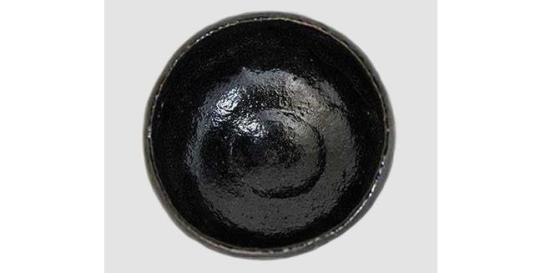
Cha-damari means the depression (the roughly circular cha-damari can be seen clearly in the above photo of the interior of a black Raku chawan) into which the matcha is scooped.
⁷Mozuno no ha i no moto ni suweraretari [百舌野ノハ井ノ本ニスヱラレタリ].
Mozuno no ha [百舌野のは], literally “with respect to (Rikyū’s compound at) Mozuno,” means we are talking about the chōzu-bachi that was installed in the roji at Mozuno.
I no moto ni sueraretari* [井のもとに据えられたり] means (the chōzu-bachi) was placed at the base of the well; or, (the chōzu-bachi) was installed beside, or in proximity to, the well. A traditional Japanese well, which is surrounded by a wooden frame, is shown below.

In other words, in the Mozuno tea compound, the tsukubai was placed near the well (perhaps as shown below -- though, of course, the author of this entry was visualizing the whole arrangement in a very different way).

This would mean that the host would not have to carry the water over a long distance in order to refill the chōzu-bachi -- so this task could be attended to just after the guests had taken their seats in the koshi-kake, without causing any delay to the host’s advancing toward the koshi-kake to invite them into the sukiya†). It would also be logical because the well would then be in close proximity to the rear veranda that functioned as an auxiliary mizuya (in this room, the function of the mizuya was primarily confined to the mizuya-dōko.[水屋洞庫] -- though, as noted in entry 36‡, there was a green-bamboo veranda on the far side of the dōko on which Rikyū was able to sit comfortably to perform other tasks connected with the preparations: this veranda also held the large ceramic mizu-kame [水甕], the jar in which dawn water was stored for use throughout the day, and probably Rikyū’s cha-usu [茶臼], tea mill, as well as a storage area for his cha-tsubo and other utensils).
Tanaka’s genpon version of the text has Mozuno no ha i no moto no kiwa ni sueraretari [モズ野ノ井ノモトノキハニスヘラレタリ].
I no moto no kiwa ni sueraretari [井のもとの際に据えられたり] means (the chōzu-bachi) was placed to one side of the base of the well. The meaning is the same, but this version resolves any unintentional ambiguity that may have been caused by the phrasing used in the toku-shu shahon text.
__________
*Sueraretari [据えられたり]: this form of the verb sueru [据える] could be understood to imply intentionality. In other words, Rikyū deliberately installed the chōzu-bachi beside the well in the roji at Mozuno.
†There is definitely a clear undercurrent that is related to the reception of guests at Mozuno. This would contract the primary narrative that was expressed in the kaki-ire that was appended to entry 77, where it was being argued that the Mozuno compound was not constructed with an eye toward the reception of guests.
‡Please refer to the post entitled Nampō Roku, Book 7 (36a): Concerning the Dōko [洞庫]. The relevant portion of that text reads:
“On a certain occasion, for a gathering that was held during the summer, the bamboo-grating was refreshed with green bamboo; and he also placed a new water-bucket [in the mizuya-dōko]. [In preparation] for the goza, the small fusuma at the front of the [dōko-]dana, and the small shōji at the back [of the mizuya-dōko], were removed.
“After the guests had taken their seats, [Ri]kyū went around from the katte to the mizuya [and sat down in front of the mizuya-dōko, facing toward the room]. Using water from the chōzu-oke [手水桶], he rinsed the chawan, and [after drying the chawan, he] arranged the chakin and chasen [in it], and lifted it up onto the [dōko’s] shelf. Then he [filled] the mizusashi by pouring the water through a koshi [コシ], and placed it [under the shelf], after which he closed the small shōji.
“From the sadō-guchi [茶堂口], he came out [into the tearoom], and performed the service [of tea].”
The URL for the complete post is:
https://chanoyu-to-wa.tumblr.com/post/698213829576982528/namp%C5%8D-roku-book-7-36a-concerning-the-d%C5%8Dko
⁸Sono-hoka roji ni yori sue-dokoro fujō nari [其外露地ニヨリ据所不定ナリ].
Sono-hoka [そのほか] means as for the rest; in other cases.
Roji ni yori [露地により] means according to (the specific design of) the roji....
Sue-dokoro fujō nari [据え所不定なり] means the place where (the chōzu-bachi should) be installed is not fixed. In other words, the host has (relatively speaking) free reign to put the tsukubai wherever he wants.
The genpon text has sono hoka roji ni yotte sue-dokoro fujō [其外露地ニ依テスヘ所不定]. Aside from several minor grammatical variations, however, the meaning (in English) would be just the same.
⁹Jōō Yamazato no chōzu-bachi ni, goku-sho no toki, ao-shiba ichi-eda kitte, chōzu mizu aratamete ato, futa no yō ni uchi-ōite hi wo saegirare-shi hataraki [紹鷗山里ノ手水鉢ニ、極暑ノ時、靑柴一枝切テ、手水水改メテ後、蓋ノヤウニ打オホヒテ日ヲ遮ラレシ働].
Jōō Yamazato no chōzu-bachi ni [紹鷗山里の手水鉢に] means at the chōzu-bachi of Jōō’s Yamazato....
Perhaps we might be able to detect a note of misunderstanding here, that the author understood yamazato [山里] to mean and actual mountain village, owned or lived in by Jōō, rather than being the name of Jōō‘s first 2-mat daime room (which he constructed in his Daikoku-an [大黒庵] compound south of Shi-jō in central Kyōto, in 1555).
Goku-sho no toki [極暑の時] means at a time of intensely hot weather....
Ao-shiba ichi-eda kitte [靑柴一枝切って] means (Jōō) cut* a branch of green brushwood....
With respect to the word ao-shiba [靑柴], the photo of the traditional Japanese well that was included under footnote 7 (above) shows the compound surrounded by a brushwood fence. Following the rainy season, these fences were generally changed (because the prolonged dampness would have caused the previous fence to begin to molder and deteriorate). This brushwood was purchased in bundles from the woodcutters (or, more likely, their agents), so Jōō seems to have taken one branch from the leftover brushwood and used that to cover his chōzu-bachi “as if it was a lid” (see below).
Chōzu mizu aratamete ato [手水水改めて後] means after the hand-washing water was refreshed....
Futa no yō ni uchi-ōite [蓋のように打ち覆いて] means (the brushwood branch) was placed down (on top of the chōzu-bachi) as if it were a lid....
Hi wo saegirare-shi hataraki [日を遮られし働き] means this was done in order to provide (the water with) protection from the sun.
The genpon text gives this sentence as: mata Jōō Yamazato no chōzu-bachi ni, goku-sho no toki, ki no eda wo kitte, futa no yō ni uchi-ōite, hi wo saegirare-shi hataraki [又紹鷗山里ノ手水鉢ニ、極暑ノ時、木ノ枝ヲ切テ、蓋ノヤウニ打ヲヽイテ、日ヲサヘギラレシハタラキ].
Mata Jōō Yamazato no chōzu-bachi ni [又紹鷗山里の手水鉢に] means “and again, at the chōzu-bachi in Jōō’s Yamazato....”
Goku-sho no toki [極暑の時] means “at a time of intense heat....”
Ki no eda wo kitte [木の枝を切って] means “(Jōō) cut a tree-branch....”
Futa no yō ni uchi-ōite [蓋のように打ち覆いて] means “and used it to cover (the chōzu-bachi) like a lid....”
Hi wo saegirare-shi hataraki [日を遮られし働き] in an effort to protect (the water) from the sun.”
___________
*In the parallel sentence in the Enkaku-ji text, which reads ao-shiba ichi-eda, chōzu-mizu aratamete ato ōite [靑柴一枝、手水水アラタメテ後ヲヽイテ] (“one branch of green brushwood, after the handwashing-water was refreshed, was placed over it”), the word “cut” is missing.
“Brushwood” was a general term for a mixture of various immature woody plants that were cut from the understory, to keep the area under the trees (the focus primarily on those areas of the montane forest that bordered the important mountain roads) open, in an effort to discourage ambush attacks by marauders or wild animals. These branches were bundled up and taken into the city, where the bundles were sold for use as a cheap source of fencing material (since the brushwood was dense enough that not even small animals could easily pass through, let alone people intent on no good). Consequently, Jōō‘s “cutting” a branch of brushwood is probably nonsense. As explained above, he likely selected a fresh branch from what remained after replacing his own brushwood fences following the end of the rainy season.
¹⁰Hito mina shiru-tokoro nari to, Kyū monogatari ari-shi [人皆知ル所ナリト、休物語アリシ].
Hito mina shiru-tokoro nari [人皆知る所なり] means this* is a place that everyone knows.
Kyū monogatari ari-shi [休物語在りし] means this† was Rikyū’s story.
Regarding the first phrase, however, the genpon text offers a very different take on the Jōō-related episode: hito mina shiru-koto nari, to Kyū monogatari arishi [人ミナシル事也、ト休物語アリシ].
Hito mina shiru-koto nari [人皆知ることなり] means “this is something that everyone knows” -- implying, perhaps, that the story of Jōō’s placing a leafy branch over his chōzu-bachi, to protect the water from the sun’s heat, was still well known (and so probably being widly imitated) during the middle of the Edo period.
__________
*Apparently the author is referring to Jōō's Daikoku-an [大黒庵] compound (in which the Yamazato-no-iori [山里ノ庵] and its roji were built during the spring or early summer of 1555) -- which is said to have been located in the first block south of Shi-jō [四條; today written 四条], east of Nishi-no-tōin dōri [西洞院通], across from the little Ebisu-dō [惠比壽堂] in the heart of Kyōto's principal commercial district. The area has been redeveloped many times since Jōō's day, and is now populated by highrises, with any reference to the original plots now lost.
Kyōto was originally laid out on a grid, with each block subsequently subdivided into individual plots by small lanes and alleys that provided east-to-west access to the compounds located therein.
†Apparently referring to the text of the whole entry -- though the assertion is difficult to believe not only because, at the beginning, Rikyū refers to himself in the third person, but also because so many of the assertions made here blatantly contradict his own known teachings. Nevertheless, this was a rhetorical device often employed in Edo period tea literature to lend credibility to the author’s claims.
==============================================
◎ If these translations are valuable to you, please consider donating to support this work. Donations from the readers are the only source of income for the translator. Please use the following link:
https://PayPal.Me/chanoyutowa
0 notes
Photo
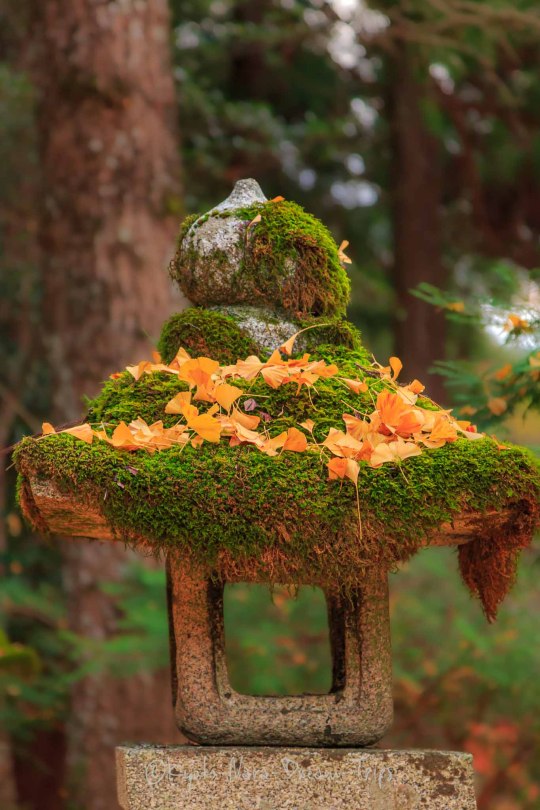
Several pictures of my visit to Iwato-ochiba-jinja, located in rural Northern Kyoto along the Kiyotaki River.
#Ginkgo tree#Iwato-ochiba-jinja#Kita-ku#Kyōto#Tsukubai#autumn#autumn photography#イチョウの木#岩戸落葉神社#蹲踞#銀杏の木
29 notes
·
View notes
Text
Hatsugama: The First Tea Ceremony in the New Year
The first class in the new year is usually not a normal class but rather a special tea ceremony called hastugama - meaning the first kettle.
Before we started, everyone got some kind of citrus tea for a good digestion. Than the highest Monk visited us and said a fee words to everyone. This is probably a bit special because I’m going to tea ceremony lesson at a temple.
This year, we all joined one big tea room which was really nice, since we are usually split into two rooms. Before we started we rinsed our hands and mouth at the tsukubai, a water basin, in the garden. Because the water was quite cold, there was also a wooden bucket with hot/warm water. This water was only used to rinse your mouth though. After we entered the tea room, one student prepared the coals and afterwards served koicha. Like last year, we used a set of two special chawan.
They are kind of red/orange on the outside and inside one of them is silver and the other one gold.
The temae will bring both chawan stacked over one another into the tea room. Therefore the silver one is slightly bigger and especially wider than the golden one.
The golden one is used first and can serve up to 4 people. The silver one can serve up to 5 people.
We have been around 15 people. So even though these chawan can serve 9 people in total, the hanto still had to bring two additional chawan from the mizuya.
We also had a look at the lits of the utensil boxes. In this way you can learn even more about the utensils and their origin. One of the additonal tea bowls has a close connection to the shichifukujin (The Seven Gods of Fortune). They are symbol for the new year, so it is best to use this chawan around this time.
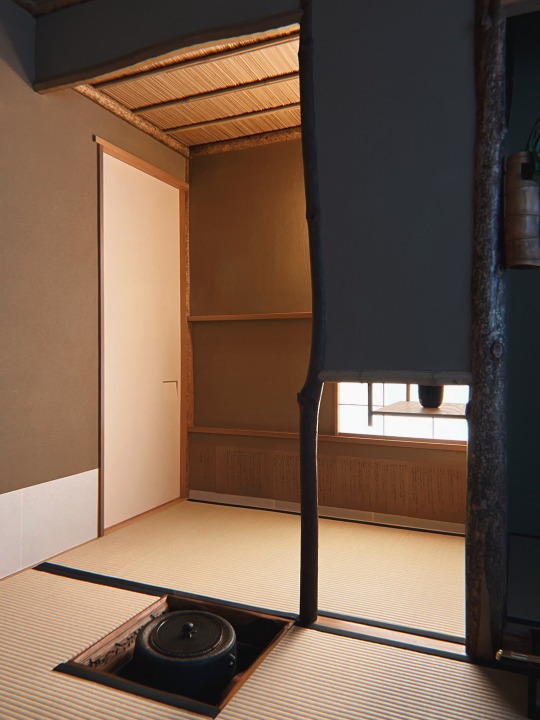

After the koicha ceremony was done, we split into groups of 6 people and joined an usucha ceremony as well. For this one we went into a much smaller and very special tea room. This one is heavily inspired by Sen no Rikyu’s tea room, yet the layout is a bit different. The atmosphere was special and it made me feel close with everyone. It was my first time to enter this tea room.
Usually you also have a kaiseki meal at a hatsugama ceremony. But at my classes we skip the meal and everyone gets a bento to take home.
Oh and I enjoyed my time so much that I just took no pictures besides the two you can see above.
#japan#tea#japanese culture#tea ceremony#matcha#omotesenke#the way of tea#茶道#抹茶#茶#hatsugama#初釜#Sen no Rikyu
1 note
·
View note
Video
☑ 180. Guardian of the house. by kanatan Abramovic
Via Flickr:
2023 10 10 Parlor child♡ Blog...~ le soleil ~ See the blog for more details ♥ ٩( ᐛ )و Thanks so much for your time !! Thank you for always having lots of Fav ♥ Thank you to all my friends who love to watch and take snaps !! ♥ love it ♥♥♥ [ - Outfit - ] ☑ NEO-Japan Yukata: !H! YUKATA (f) model ' HONENOKE ' Yukata HUD: !H! YUKATA (f) Houichi Fat HUD ☑ Novel Events Hair: PADO // devi hair Obi: HONENOKE HEKOOBI1 (f) model Obi2: HONENOKE HEKOOBI2 (f) model Obi HUD: HONENOKE HEKOOBI1 (f) Kanoko HUD Obi HUD2: HONENOKE HEKOOBI2 (f) Kiku HUD Pipe: 2.*N*Kingyo Pipe A-2 ' NAMINOKE ' [ - Makeup - ] Skin: (Enfer Sombre*) LeLutka EvoX Skin - Mannequin - Nikki Lip: 10000&Co. Natural LIP v-1G evo-x Eyeliners: GOREGLAM 'Flutter' Eyeliners EVO X BOM Eyes: MAOER-EYES V19 SET 1 [ - Decoration - ] Skybox: MINIMAL - Sora Gacha RARE Cat: {-Maru Kado-} Fish pillow and cat_Plain Origami: {-Maru Kado-} Origami set_butterfly Otedama: [[RH]] SAIHOUBAKO set Tree: 05_8f8 - Art of Nature - Grown Maple Vase: 14_8f8 - Art of Nature - Young Maple WOOD Vase: 10_8f8 - Art of Nature - Olivia WOOD Tsukubai: [MG]TsukubaiBbY ' MONKEYGirl ' Zaisu: [MG]DOKODEMO KOAGARI-ZAISU Botan2 4-1 Toro: booN-kura Toro nascent
#SecondLife#SL#Snapshot#SS#SecondLifeFashion#SecondLifeBlog#SecondlifeFurniture#Fashion#Furniture#FashionBlog#Fantasy#EVENT#Events#Decoration#DECO#Decor#Blog#Japan#NEO-JAPAN#Novel_Events#HONENOKE#PADO#NAMINOKE#EnferSombre#10000&Co.#GOREGLAM#MAOER#MINIMAL#MaruKado#RH
0 notes
Text
it's been weeks since i could travel back to the teahouse, and give and receive under sensei.
i feel like crying. i want to cry, i want to fill the tsukubai with my tears. i haven't been the tea person i want to be, i haven't practiced as much as i should. i want to kneel at the entrance with the gravel cutting my knees and lay my forehead on the stepping stone, as for a beheading.
i come into the tearoom wounded, and let the steam and the scent of the tea sink into my heart.
i don't cry. it would stain the tatami.
0 notes
Text
purification by water
- jewish mikveh associated with the impurity of death, periods, etc. - earliest evidence goes back to 1st century BCE?
- Mandean masbuta (weekly baptism in flowing water ie. rivers on Sundays
- Mandean tamasha: triple immersion in rivers required by women after periods, childbirth, sex, etc.
- Mandean Mandis must be built by rivers
- Brahmins bathing in the ganges
- Brahmin “punyahavachanam” - ritual of sprinkling water over people and items on important occasions
- Abisheka - ritualistic bathing a religious image or idol with water, curd, milk, etc
- men are pure after bathing after childbirth but women aren’t for a month
- Brahmin requirement to bathe after a death ceremony
- shinto misogi
- tsukubai
- washing the feet of clergy
- Christian baptism
- islamic ritual ablutions, wudu and ghusl
1 note
·
View note


